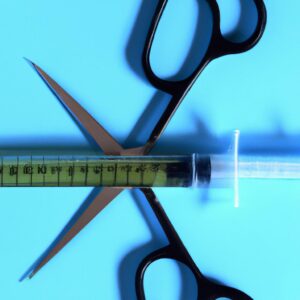Unlock Optimal Women’s Health: Hormones, Menopause & Reproductive Health

Introduction
Women’s health is an incredibly important part of overall health and wellbeing. It covers a vast array of topics ranging from hormones, menopause, and reproductive health, to fertility, contraception, sexually transmitted infections, and even common gynecological disorders. This guide serves as a comprehensive introduction to women’s health, explaining the various factors at play and how to best take care of your health in each area.
Whether you’re looking to better understand your own body or care for a loved one, this guide is here to help. Read on to learn more about hormones, menopause, reproductive health, fertility, contraception, sexually transmitted infections, common gynecological disorders, menstruation, breast health, nutrition, exercise, and more.
Hormones
Hormones are chemical messengers that play a vital role in women’s health. They are produced by the endocrine system and have many important functions, such as regulating energy levels and metabolism, sexual development, reproductive cycles, and overall wellbeing.
There are different types of hormones that women produce including estrogens, progesterone, and testosterone. Estrogen helps regulate the menstrual cycle, while progesterone is involved in ovulation and preparing the uterus for a potential pregnancy. Testosterone helps regulate energy, libido, and other sexual characteristics.
Hormonal imbalances can occur due to various reasons such as stress, diet, lifestyle, or medication. Common symptoms of hormonal imbalances include changes in menstrual cycle, weight gain, fatigue, and low libido. Treatment of hormonal imbalance depends on the underlying cause and can include lifestyle changes, supplements, and medications.
Menopause
Menopause is a natural part of the female life cycle and can occur anytime between the ages of 45 and 55, although it is most common between the ages of 47 and 53. During menopause, the body stops producing estrogen and progesterone, leading to hormonal imbalances and physical changes throughout the body.
The most common and well known symptom of menopause is hot flashes. Hot flashes are sudden, overwhelming feelings of warmth that can cause you to experience excessive sweating, heart palpitations, and even nausea. Other common symptoms include night sweats, depression, anxiety, insomnia, vaginal dryness, weight gain, and loss of libido.
There are several ways to manage and cope with the symptoms of menopause. Hormonal therapy, such as the use of estrogen supplements, is an effective way to treat menopausal symptoms. Natural therapies such as acupuncture, massage, and herbal treatments can also help relieve some of the symptoms of menopause. Lifestyle changes such as regular exercise, stress management, healthy eating, and adequate sleep can also help to reduce the effects of menopause.
Reproductive Health
Reproductive health is a broad term that refers to the physical, mental, and social wellbeing of individuals in relation to their sexuality and reproductive functions. Reproductive health is an important factor in overall health and well-being for women of all ages, from adolescence through menopause. It involves understanding and taking control of one’s reproductive decisions and options.
There are many common challenges related to reproductive health such as infertility, contraception, sexually transmitted infections (STIs), and gynecological disorders. It is important to stay informed about these issues and seek medical guidance when needed. Preventive care is also key, such as routine check-ups with a gynecologist to help keep your reproductive system healthy.
Fertility for Women
Having a child is a milestone that many women aspire to, and the process of becoming pregnant can be complex. It is important for women to understand the basics of fertility and the steps they can take towards achieving pregnancy.
Fertility is the ability to conceive a child and it can be affected by a variety of factors including age, lifestyle, health conditions, and genetics. For women, fertility begins to decline naturally in their late 20s, and the chances of conceiving decrease even more after age 35.
The most common course of action for women looking to become pregnant is to visit a physician for fertility testing and evaluation. These tests can determine if there are any medical issues that need to be addressed before conception. Additionally, the doctor may recommend lifestyle changes such as limiting alcohol consumption and quitting smoking to further improve the odds of achieving pregnancy.
Once the medical evaluation is complete, a woman may choose to take medications or undergo other treatments prescribed by her doctor. These treatments include intrauterine insemination (IUI) and in vitro fertilization (IVF). Depending on the individual’s circumstances, other options may also be available.
It is important for women to know that they have options and resources available to help them become pregnant if they so choose. Knowing the basics of fertility and taking the appropriate steps can help them have a greater chance of achieving pregnancy.
Contraception
Contraception is an important part of family planning and women’s health. It is a way for you to control your fertility. There are many different types of contraception available, all of which have varying levels of effectiveness.
The most common types of contraception include:
- Oral contraceptives, such as the Pill or ‘the pill’.
- Barrier methods, such as condoms, diaphragms and FemCap.
- Long-acting reversible contraception (LARC) methods, such as Implanon, IUDs, and contraceptive injections.
- Permanent methods, such as a vasectomy for men and tubal ligation for women.
It is important for women to understand how contraception works in order to make informed decisions about their fertility. Different types of contraception have different levels of effectiveness, so it is important to understand the potential risks and benefits of each method.
Your doctor can provide more information and advice about the best contraception for you. They can help to choose the most suitable option based on your needs, lifestyle, and health.
Sexually Transmitted Infections (STIs)
Sexually transmitted infections, commonly known as STIs, are infections that spread through sexual contact with an infected person. Some common STIs include Chlamydia, Gonorrhea, Human Papillomavirus (HPV), Genital Herpes, and Syphilis.
Symptoms of STIs can vary and sometimes there are no symptoms at all. Some of the more common signs include genital sores or pain, discharge from the penis or vagina, itching, burning sensations, fever, muscle aches, and swollen glands.
To prevent STIs, the best protection is abstinence and to stay with one partner who is known to be free of any infection. It is important to get tested regularly for STIs if you are sexually active. Protection, such as condoms and dental dams, can also be used to help reduce the risk of transmitting STIs.
Treatment for STIs depends on the type of infection and it can range from taking medications to having surgery. It is important to complete the treatment in order to avoid further complications or spreading the infection to others.
Common Gynecological Disorders
Common gynecological disorders can have a major impact on a woman’s health and wellbeing. Here are just some of the more common ones, along with the treatments available:
- Endometriosis: Endometriosis is a condition in which the tissue that normally lines the uterus grows outside of the uterus, commonly on the ovaries, bowels, or other pelvic structures. Treatments for endometriosis may include medications, minimally invasive surgeries, or other therapies.
- Uterine Fibroids: Uterine fibroids are non-cancerous growths in the uterus that can lead to symptoms such as heavy menstrual bleeding, pain when urinating, fatigue, and back pain. Treatment typically includes medications, minimally invasive surgery, or traditional surgery.
- Ovarian Cysts: Ovarian cysts are fluid-filled sacs in the ovaries that can cause pain and other symptoms. Treatments for ovarian cysts range from watchful waiting to medications and sometimes surgery.
- Polycystic Ovary Syndrome (PCOS): PCOS affects the hormones in women of reproductive age. Symptoms can include irregular menstrual cycles, excessive hair growth, weight gain, and infertility. Treatment focuses on lifestyle changes such as a healthy diet and regular exercise, but medications and hormonal therapy may also be necessary.
- Vulvodynia: Vulvodynia is a chronic condition characterized by vulvar pain and discomfort. Treatment options vary depending on the type of vulvodynia, but they include medications, creams, physical therapy, and surgery.
If you are experiencing any of these symptoms, it is important to discuss them with your doctor. Early detection and treatment of these conditions can prevent them from becoming worse and help you avoid related complications.
Menstruation
Menstruation is a part of the female reproductive cycle that affects most women. During menstruation, the uterus sheds its lining and blood flows out of the body through the vagina. The average menstrual cycle lasts 28 days, however each woman’s cycle duration can vary. On average, a period can last anywhere from 2-7 days.
Signs of normal menstruation include:
- Regular menstrual cycles (approximately every 28 days)
- No more than 1-2 days of heavy bleeding
- Minimal to no pain
On the other hand, signs of abnormal menstrual periods include:
- Bleeding for longer than 7 days
- Heavier-than-normal bleeding or flooding
- Excessively painful cramps
- Irregular menstrual cycles (longer than 35 days without a period)
If you have any abnormal bleeding or pain, consult with your doctor for further advice.
Breast Health
Breast health is an important subject for any woman to stay informed about. Being self-aware of your breasts and understanding the importance of regular breast exams can help you stay ahead of any potential issues. It is recommended that women perform monthly self-exams in order to monitor their breast health and stay vigilant. Additionally, most women should visit their doctor once per year for a more thorough exam.
During these examinations, your doctor may take a close look at your breasts to check for any lumps, bumps, or changes in shape or size. He or she may also suggest imaging such as mammograms or ultrasounds if needed. While these tests can detect some problems, some breast concerns may be too small for them to detect.
Unfortunately, there are still many myths circulating about breast health and there are several dangerous misconceptions. It is important to remember that breast cancer can occur in both men and women, that breast cancer is not always detectable through self-exams, and that genetics can play a role in cancer development. In addition, just because you are young doesn’t mean that you are immune from developing breast cancer.
It’s essential that all women know the facts on breast health in order to protect their wellbeing. Being aware of any potential changes in your breasts, checking in regularly with a doctor, and taking steps to reduce your risk are all important parts of being proactive about your health.
Nutrition and Exercise for Women’s Health
Maintaining a healthy lifestyle is an important part of optimal health, and this includes paying attention to what you eat and the physical activities you undertake. Eating nutritious foods and engaging in regular exercise can have many positive impacts on women’s overall health and well-being.
Nutritious foods contain essential vitamins, minerals, and other nutrients that are important for keeping our bodies functioning properly. Eating a balanced diet can help to keep energy levels high, and improve your mood, skin, and hair. It can also protect against illnesses such as heart disease, diabetes, and certain types of cancer.
In addition to eating a healthy diet, engaging in regular physical activity can help you maintain a healthy weight, reduce stress, and improve your overall fitness. Exercise can help to increase strength and flexibility, reduce risk of diseases, improve sleep quality, and even boost cognitive performance.
A few simple changes to your daily routine can help you reap these amazing benefits. Take time to prepare nutritious meals at home with fresh ingredients like fruits, vegetables, whole grains, and lean proteins. And make sure to get at least 30 minutes of physical activity each day – whether it’s taking a walk around the neighborhood or joining an online yoga class.
Conclusion
Women’s health is an important part of overall health and wellbeing. Knowing the basics of hormones, menopause, reproductive health, fertility, contraception, STIs, gynecological disorders, menstruation, breast health, nutrition and exercise can help you to understand your body better and manage any issues that might arise. To make sure that you are healthy, it is recommended to consult with a doctor if you experience any changes or symptoms. Taking the steps to stay informed and involved in your care will help ensure that you can get the most out of your health.
comments: 0







